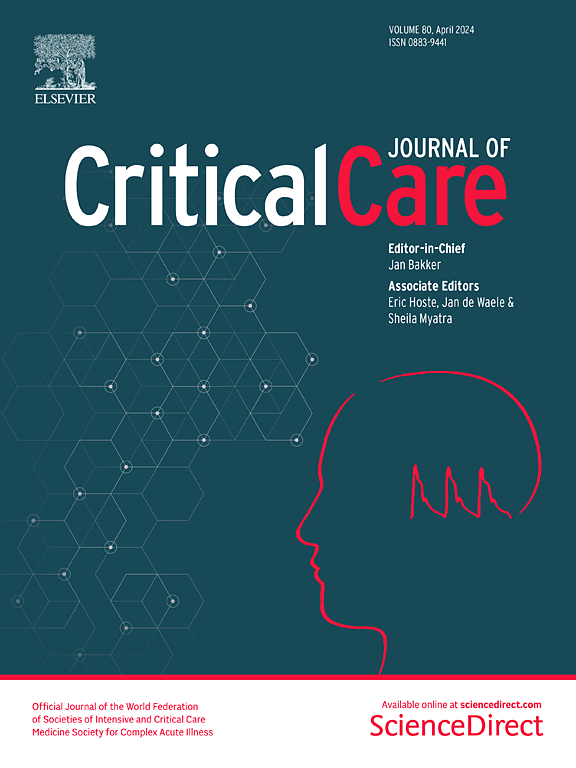Mortality in septic patients treated with short-acting betablockers: a comprehensive meta-analysis of randomized controlled trials
IF 8.8
1区 医学
Q1 CRITICAL CARE MEDICINE
引用次数: 0
Abstract
Treatment with short-acting betablockers in septic patients remains controversial. Two recent large multicenter trials have provided additional evidence on this therapeutic approach. We thus performed a meta-analysis, including the most recent data, to evaluate the potential impacts of treatment with short-acting betablockers on mortality in adult septic patients. The data search included PubMed, Web of Science, ClinicalTrials.gov and the Cochrane Library. A meta-analysis of all eligible peer-reviewed studies was performed in accordance with the PRISMA statement. Only randomized, controlled studies with valid classifications of sepsis and intravenous treatment with short-acting betablockers (landiolol or esmolol) were included. Short-term mortality served as the primary endpoint. Secondary endpoints included effects on short-term mortality regarding patient age and cardiac rhythm. A total of seven studies summarizing 854 patients fulfilled the predefined criteria and were included. Short-term mortality as well as pooled mortality (longest period of data on mortality) was not significantly impacted by treatment with short-acting betablockers when compared to the reference treatment (Risk difference, − 0.10 [95% CI, − 0.22 to 0.02]; p = 0.11; p for Cochran’s Q test = 0.001; I2 = 73%). No difference was seen when comparing patients aged < 65 versus ≥ 65 years (p = 0.11) or sinus tachycardia with atrial fibrillation (p = 0.27). Despite statistical heterogeneity, no significant publication bias was observed. Administration of short-acting betablockers did not reduce short-term mortality in septic patients with persistent tachycardia. Future studies should also provide extensive hemodynamic data to enable characterization of cardiac function before and during treatment.脓毒症患者使用短效受体阻滞剂治疗仍存在争议。最近的两项大型多中心试验为这种治疗方法提供了更多证据。因此,我们进行了一项包括最新数据在内的荟萃分析,以评估使用短效倍他受体阻滞剂治疗对成人脓毒症患者死亡率的潜在影响。数据搜索包括 PubMed、Web of Science、ClinicalTrials.gov 和 Cochrane 图书馆。根据 PRISMA 声明,对所有符合条件的同行评审研究进行了荟萃分析。仅纳入了对脓毒症进行有效分类并使用短效受体阻滞剂(兰迪洛尔或艾司洛尔)进行静脉治疗的随机对照研究。短期死亡率为主要终点。次要终点包括患者年龄和心律对短期死亡率的影响。共有七项研究的 854 名患者符合预定标准并被纳入研究。与参考治疗相比,短效受体阻滞剂治疗对短期死亡率和集合死亡率(死亡率数据的最长时间段)没有显著影响(风险差异,- 0.10 [95% CI,- 0.22 至 0.02];P = 0.11;Cochran's Q 检验的 P = 0.001;I2 = 73%)。在比较年龄小于 65 岁与≥ 65 岁的患者(p = 0.11)或窦性心动过速与心房颤动的患者(p = 0.27)时,未发现差异。尽管存在统计学异质性,但未发现明显的发表偏倚。使用短效受体阻滞剂并不能降低持续性心动过速脓毒症患者的短期死亡率。未来的研究还应提供广泛的血液动力学数据,以确定治疗前和治疗期间心脏功能的特征。
本文章由计算机程序翻译,如有差异,请以英文原文为准。
求助全文
约1分钟内获得全文
求助全文
来源期刊

Critical Care
医学-危重病医学
CiteScore
20.60
自引率
3.30%
发文量
348
审稿时长
1.5 months
期刊介绍:
Critical Care is an esteemed international medical journal that undergoes a rigorous peer-review process to maintain its high quality standards. Its primary objective is to enhance the healthcare services offered to critically ill patients. To achieve this, the journal focuses on gathering, exchanging, disseminating, and endorsing evidence-based information that is highly relevant to intensivists. By doing so, Critical Care seeks to provide a thorough and inclusive examination of the intensive care field.
 求助内容:
求助内容: 应助结果提醒方式:
应助结果提醒方式:


